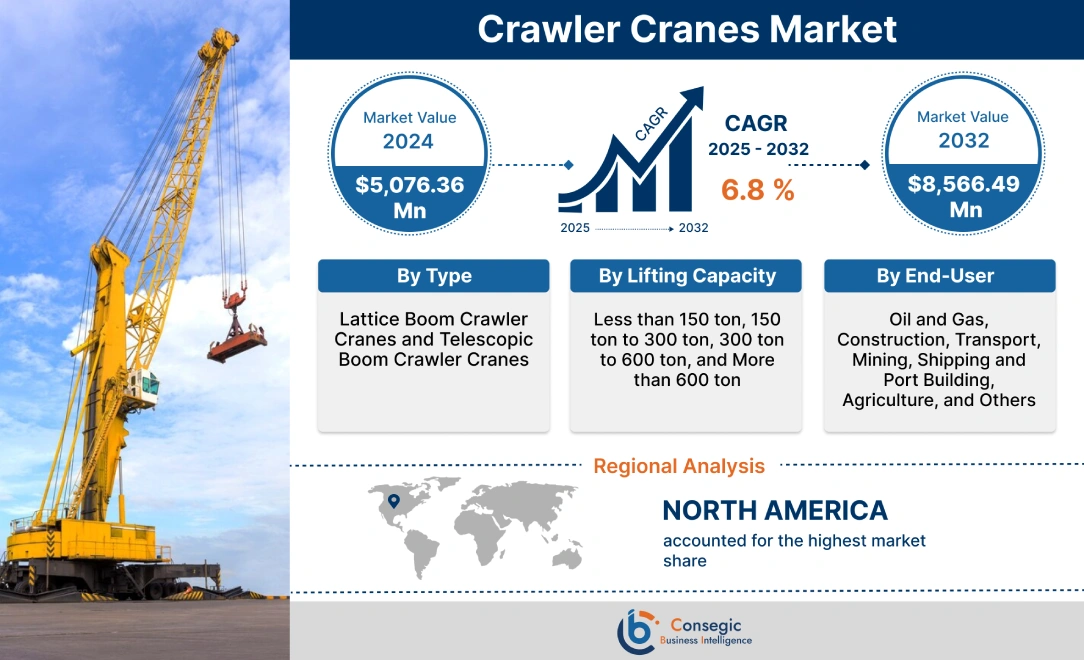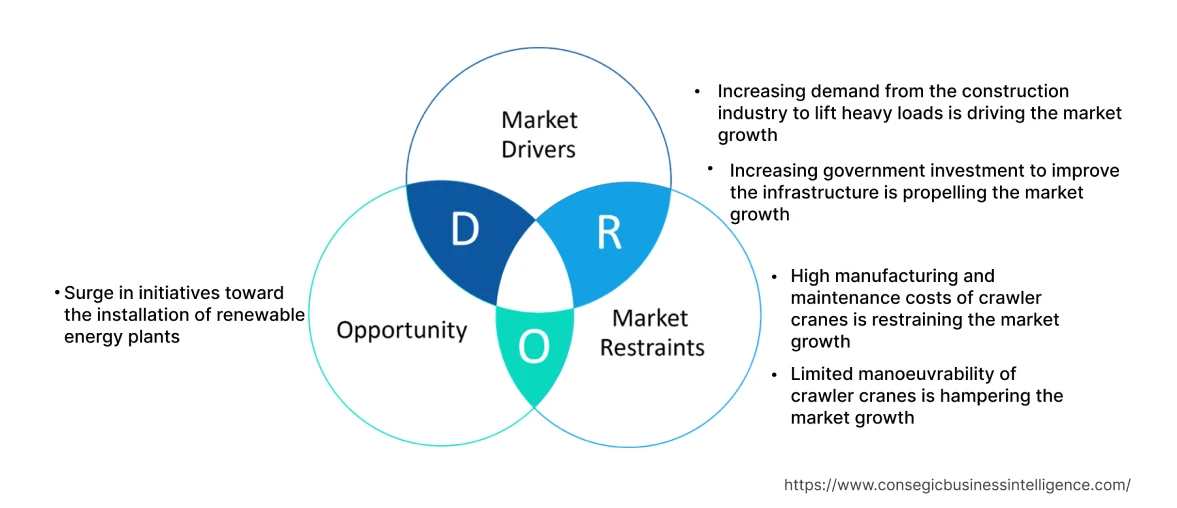Crawler Cranes Market Size :
Crawler Cranes Market size is estimated to reach over USD 8,566.49 Million by 2032 from a value of USD 5,076.36 Million in 2024, growing at a CAGR of 6.8% from 2025 to 2032.
Crawler Cranes Market Scope & Overview:
Crawler cranes are defined as cranes, mounted on an undercarriage comprising a set of tracks including trackpads, sprockets, idlers, and others that allow for improved mobility and stability. The cranes are available in a wide range of lifting capacities for numerous construction and industrial applications, including heavy-duty work, and bridge construction, among others. In addition, the cranes offer high lifting capacity and stability to lift and move heavy loads from one location to another with precision and control. Furthermore, crawler cranes feature high reliability and operational efficiency coupled with flexibility and safety.
Crawler Cranes Market Insights :
Crawler Cranes Market Dynamics - (DRO) :
Key Drivers :
Increasing demand from the construction industry to lift heavy loads is driving the market growth
The growing demand for crawler cranes to lift heavy loads in the construction industry is the key factor responsible for accelerating the growth of the market. Crawler cranes have high lifting capacities ranging from 150 tons to 600 tons that allows the crane to move heavy materials, equipment, and prefabricated components on construction sites. In addition, the advancements in engine technology including the emergence of the safety features including ECO winch and auto idle stop function perform the operations efficiently by consuming less fuel is also propelling the market growth. Moreover, the advent of advanced features, namely swing brake pedal and swing restriction device to enhance the safety of the crane operator is boosting the market growth. For instance, in May 2020, Sumitomo Heavy Industries Construction Cranes Co., Ltd. (HSC) introduced SCX1800A-3, a crawler crane with an ECO winch and auto idle stop function. The crane uses a swing brake pedal to improve the safety of workers, hence contributing notably in driving the market growth.
Increasing government investment to improve the infrastructure is propelling the market growth
The increasing investment by the government to enhance the infrastructure raises the demand for advanced crawler cranes to effectively handle industrial equipment. Governments allocate significant assets for the construction of large-scale infrastructure projects including highways, bridges, airports, railways, and urban development. The projects require heavy lifting and construction activities including heavy concrete or steel girders and crawler cranes are considered ideal to handle the lifting tasks effectively. Subsequently, the increasing investment by the government to improve the infrastructure is contributing considerably in boosting the growth of the crawler cranes market. For instance, under the Autumn Budget 2021, the United Kingdom government invested USD 7.73 Million in the Transport Decarbonisation Plan for the decarbonization of buildings across the UK. The implementation of architectural plans by the government thus contributes in driving the growth of the market.
Key Restraints :
High manufacturing and maintenance costs of crawler cranes is restraining the market growth
The cost of production and maintenance of crawler cranes is expensive which deters smaller construction companies from entering the market. The equipment used in the manufacturing of crawler cranes including sprockets , trackpads, and idlers are expensive. In addition, the operating and maintenance expenses including fuel costs, regular maintenance, and repairs of crawler cranes are also high, further limiting the adoption of crawler cranes in industrial sectors. Consequently, the high production, operation, and maintenance costs is hampering the growth of the crawler cranes market.
Limited manoeuvrability of crawler cranes is hampering the market growth
The limited manoeuvrability of crawler cranes owing to inability of crawler cranes to navigate through narrow spaces acts as the major restraint for the growth of the market. In addition, crawler cranes need to be transported with the assistance of trucks from one construction site to another, resulting in additional expenses, thus impeding the growth of the global crawler crane market.
Future Opportunities :
Surge in initiatives toward the installation of renewable energy plants
The growing trend toward the installation of renewable energy plants, particularly wind power, is anticipated to create opportunities for the growth of the crawler cranes market. Crawler cranes are essential to meet the growing demands for lifting capacity and hoisting height for erecting wind turbines. In addition, the advancements in crane systems including the emergence of a V-frame ballast system that enables the adjustment of the ballast radius is expected to increase the demand for crawler cranes in the installation of wind plants. For instance, in April 2023, Liebherr introduced LR 1700-1.0W that offers improved prerequisites for the efficient construction of modern wind turbines in wind farms located at onshore locations.
Crawler Cranes Market Report Insights :
| Report Attributes | Report Details |
| Study Timeline | 2019-2032 |
| Market Size in 2032 | USD 8,566.49 Million |
| CAGR (2025-2032) | 6.8% |
| By Type | Lattice Boom Crawler Cranes and Telescopic Boom Crawler Cranes |
| By Lifting Capacity | Less than 150 ton, 150 ton to 300 ton, 300 ton to 600 ton, and More than 600 ton |
| By End-User | Oil and Gas, Construction, Transport, Mining, Shipping and Port Building, Agriculture, and Others |
| By Region | Asia-Pacific, Europe, North America, Latin America, Middle East & Africa |
| Key Players | XCMG Group, The Manitowoc Company Inc., Terex Corporation, Tadano Ltd., Sennebogen Erich Holding GmbH & Co. KG, Sany Group, PVE Cranes Middle East LLC, Liebherr-International Deutschland GmbH, Kato Works Co Ltd, Hitachi Sumitomo Heavy Industries Construction Crane Co. Ltd. |
Crawler Cranes Market Segmental Analysis :
By Type :
The type segment is bifurcated into lattice boom crawler cranes and telescopic boom crawler cranes. Telescopic boom crawler cranes accounted for the largest market share in 2024 owing to the ability of cranes to extend and retract varying boom lengths and configurations. The flexibility enables the telescopic crane to reach different heights in bridge construction, building and below-ground construction, and pile driving during sheet pile installation. Consequently, the improved flexibility offered by the telescopic boom crawler cranes is contributing significantly in propelling the market growth. For instance, in February 2023, SENNEBOGEN introduced the 80-tonner 683 E telescopic boom crawler crane to expand its crawler crane portfolio. The crane is equipped with a winch motor and is employed in various applications including bridge construction and building construction.
Lattice boom crawler cranes are expected to register the fastest CAGR during the forecast period. The capability of lattice boom cranes to manage heavier loads in comparison to telescopic cranes is projected to fuel the market growth. In addition, the emergence of advanced systems including the Crane Control System (CCS) to maximize the lifting capacities along with offering improved flexibility is also predicted to promote market growth. Moreover, the increasing demand for advanced lattice boom cranes with CCS system in the oil and gas industry and power plants is further contributing to the growth of the segment in upcoming years.
By Lifting Capacity :
The lifting capacity segment is classified into less than 150 ton, 150 ton to 300 ton, 300 ton to 600 ton, and more than 600 ton. 150 ton to 300 ton segment accounted for the largest market share of 33.27% in 2024 as crawler cranes in the mentioned capacity range are utilized in the construction of skyscrapers. Crawler cranes within this capacity range are ideal for infrastructure development projects including bridges, highways, and railways to handle the lifting and placement of large concrete segments, beams, and prefabricated elements. In addition, cranes with a lifting capacity of 150 ton to 300 ton are highly compact and maneuverable, further driving the growth of the market. For instance, in February 2020, Manitowoc introduced MLC150-1 with a lifting capacity of 150 ton for construction purposes. The crane offers improved compactness, maneuverability, and increased hook height designed for transportation with minimal permitted loads.
More than 600 ton segment is projected to witness the fastest CAGR during the forecast period. The growth of the 600 ton capacity crawler cranes is attributed to the increasing trend toward the installation of large-scale renewable energy plants. In addition, the improvements in the design of cranes including high-strength lattice boom to provide greater lifting capacity and the positioning of lower rollers to maintain the frame strength are also contributing to the market growth. In conclusion, the improvements in high-capacity crawler crane design along with the growing number of renewable energy projects are expected to drive the market growth in upcoming years.
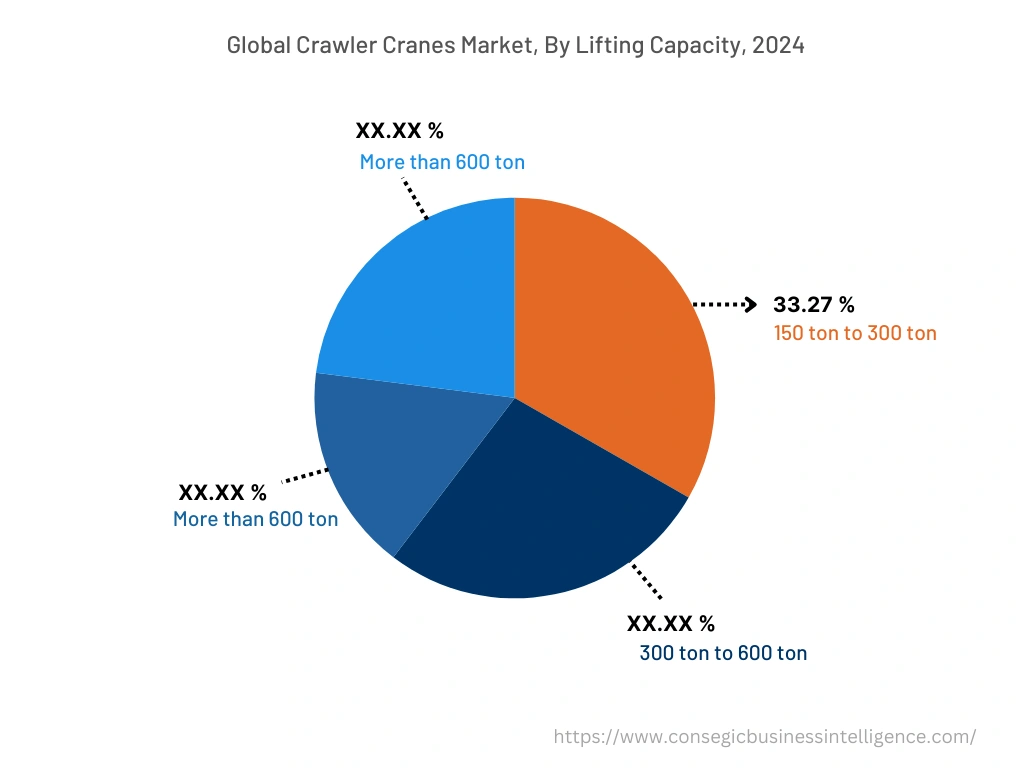
By End-User :
The end-user segment is divided into oil and gas, construction, transport, mining, shipping and port building, agriculture, and others. The construction industry accounted for the largest market share in 2024 owing to the increasing application of cranes in bridge construction projects. In addition, crawler cranes are ideal for working on rough terrains and uneven surfaces further increasing the adoption of cranes by the construction industry. Moreover, crawler cranes are also employed in demolition projects for the controlled dismantling of structures by safely breaking large sections of buildings. Consequently, the increasing application of crawler cranes in bridge construction and demolition of buildings is contributing notably in driving the growth of the market.
The oil and gas industry is projected to register the fastest CAGR during the forecast period. Crawler cranes are employed in the construction of oil refineries and petrochemical plants and for installing heavy equipment including distillation columns, pressure vessels, and storage tanks. In addition, the cranes are also used to lift heavy platform modules and jacket structures in the oil and gas industries. Moreover, Middle East countries including the United Arab Emirates and Kuwait encompass large oil and gas industries that increase the demand for advanced crawler cranes. For instance, according to the International Energy Agency (IEA), the crude oil production in Saudi Arabia accounted to 10.43 million barrels per day in February 2023.
By Region :
The regional segment includes North America, Europe, Asia Pacific, Middle East and Africa, and Latin America.
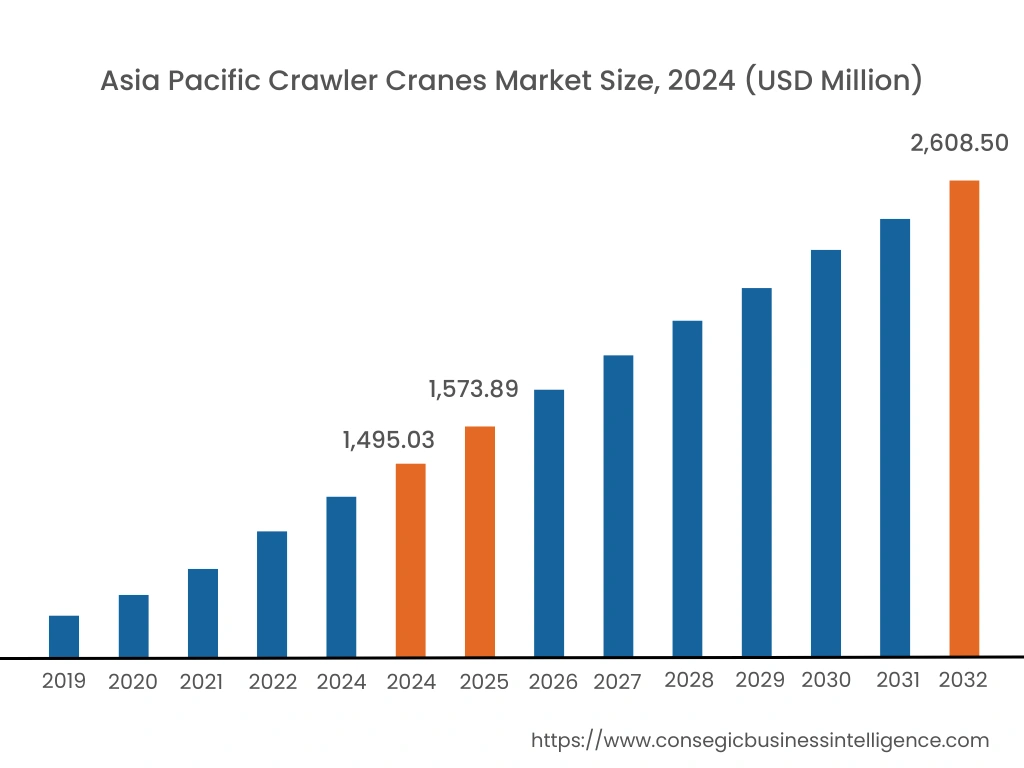
North America accounted for the largest revenue share in the year 2024 owing to the increasing demand for crawler cranes in industries including transportation and logistics. Additionally, the region is witnessing significant growth in wind energy projects, particularly in the United States that increase the demand for crawler cranes for the installation and maintenance of wind turbines. Moreover, the presence of key players in the region constantly applies strategic decisions to gain a competitive edge and also to strengthen the market position. Consequently, the rising demand for advanced crawler cranes from various industries and the presence of key manufacturers serve as the primary factors responsible for accelerating the growth of the crawler crane market in the region. For instance, in November 2022, ATLAS Crane Service purchased multiple crawler cranes for approximately USD 60 Million from Liebherr in Bauma 2022. The order demonstrates Atlas Crane's investment in improving the renewable energy infrastructure and also to expand its feet in the North American market.
Asia Pacific is accounted to hold revenue of USD 1,495.03 million in the year 2024 and anticipated to reach USD 2,608.50 million by 2032, growing at a CAGR of 7.20% during forecast period, 2024-2032. The region is also anticipated to grow at the fastest rate during the projected period. In addition, in the region, China accounted for the maximum revenue share of 26.6% in the year 2024. The growth is endorsed by the expanding construction industry in countries including India and China owing to the easy availability of raw materials. Subsequently, the expansion of the construction industry raises the demand for advanced crawler cranes for loading and unloading goods. Additionally, crawler cranes are also required for easy handling of construction equipment which is expected to further drive the growth of the market in Asia-Pacific countries.
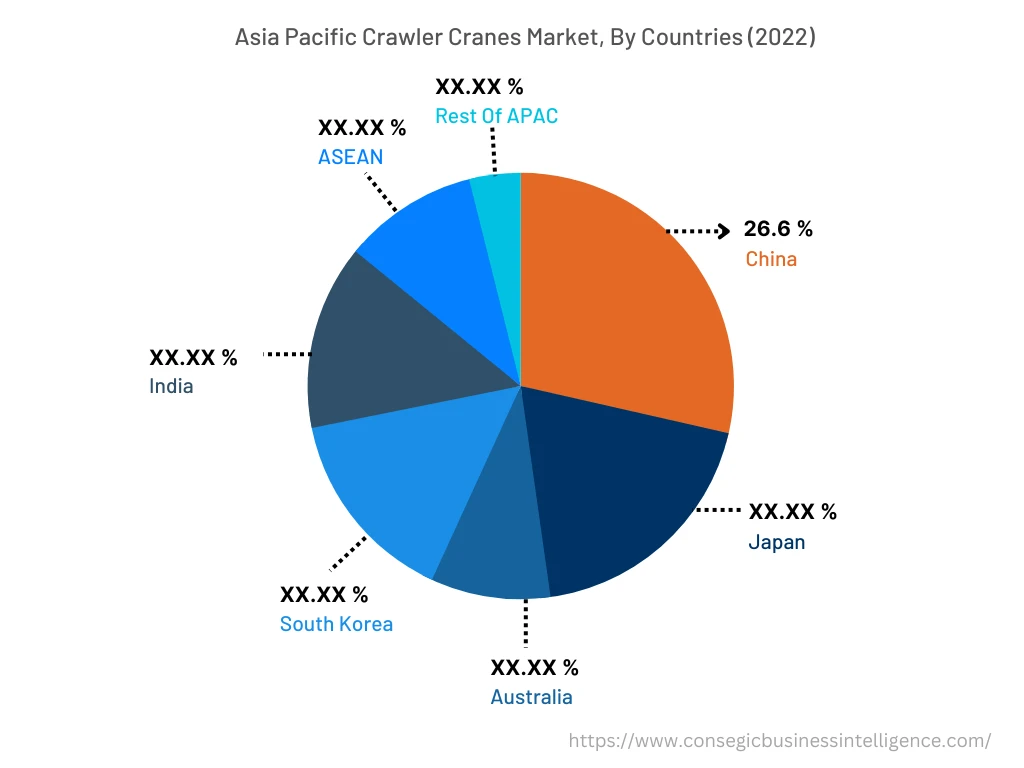
Top Key Players & Market Share Insights:
The landscape of the Crawler Cranes Market is highly competitive. The key players in the market are adopting strategies for acquisitions and mergers, and product innovations to stay competitive in the market. Following are the major market players that comprise the latest market concentration -
- XCMG Group
- The Manitowoc Company Inc.
- Terex Corporation
- Tadano Ltd.
- Sennebogen Erich Holding GmbH & Co. KG
- Sany Group
- PVE Cranes Middle East LLC
- Liebherr-International Deutschland GmbH
- Kato Works Co Ltd
- Hitachi Sumitomo Heavy Industries Construction Crane Co. Ltd.
Recent Industry Developments :
- In October 2022, Liebherr introduced HS 8070.1, a duty cycle crawler crane for deep foundation work, material handling, and lifting work. The crane has a lifting capacity of 70 tonnes and is fitted with a modular system to improve operational efficiency.
- In April 2022, Manitowoc launched GHC85, a telescopic crane offering 100% pick and carry capability across its 4°, 1.5°, and 0.6° load chart that makes the crane ideal for various applications including setting poles and moving solar panels.
Key Questions Answered in the Report
What is a crawler crane? +
A crawler crane is a type of mobile crane that is equipped with tracks or crawlers instead of wheels. The crane is designed for heavy lifting and transportation of materials on rough or uneven terrain. The tracks provide stability and enable the crane to maneuver over various types of surfaces, including soft or muddy ground.
What specific segmentation details are covered in the crawler crane market report, and how is the dominating segment impacting the market growth? +
The report consists of segments including type, lifting capacity, end-user, and region. Each segment has a key dominating sub-segment being driven by industry trends and market dynamics. For instance, the type segment has witnessed telescopic boom crawler cranes as the dominating segment in the year 2024. The growth is endorsed by the ability of cranes to extend and retract varying boom lengths and configurations.
What specific segmentation details are covered in the crawler cranes market report, and how is the fastest segment anticipated to impact the market growth? +
The report consists of segments including type, lifting capacity, end-user, and region. Each segment is projected to have the fastest-growing sub-segment fuelled by industry trends and drivers. For instance, in the lifting capacity segment, more than 600 ton capacity cranes is anticipated to witness the fastest CAGR growth during the forecast period. The growth is attributed to the increasing trend toward the installation of large-scale renewable energy plants.
What specific segmentation details are covered in the truck-mounted crane market report, and how does each dominating segment is influencing the demand globally? +
As aforementioned, each dominating segment is influencing the demand globally due to growing industrial needs. Moreover, fluctuation in demand being witnessed from different sectors is responsible for driving the crawler crane market.
